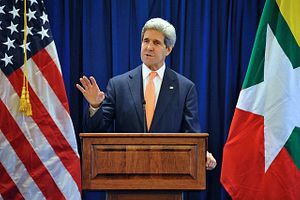Although China has tactically reduced tensions in the South China Sea (SCS) by removing its oil rig HD981, paramilitary and naval forces from Vietnam’s exclusive economic zone (EEZ), the region was still high on the agenda at the 21st ASEAN Regional Forum (ARF) on August 10 in Naypyidaw, Myanmar. U.S. Secretary of State John Kerry proposed a “freeze” on actions in the SCS. Chinese Foreign Minister Wang Yi for the first time brought up a “dual-track” approach to solving SCS problems, and called for a ”21st century security concept.” The two initiatives seem to belong to two different worlds.
Stark Differences
Top Chinese and U.S. diplomats at the ARF introduced very different descriptions of the situation in the SCS. “Some claimants have taken provocative steps that are obviously aimed at changing the status quo. Tensions have spiked… Trade has suffered. And relations between neighbors have deteriorated… Vessels have engaged in dangerous behavior and are challenging each other… That’s why we questioned China’s decision to begin drilling operations – accompanied by numerous paramilitary vessels,” said Kerry. In response, Wang challenged the U.S.’s advocacy by arguing that the “situation in the SCS is generally stable, and the freedom of navigation there has never seen any problems,” and “countries out of the region can have their legitimate concerns, but if they come here for finger-pointing, then we are opposed to that.”
They also introduced initiatives aimed at countering each other. The nature of the freeze is to voluntarily and jointly halt the sorts of activities that would complicate or escalate disputes, asking parties to: (i) refrain from establishing new outposts on unoccupied features or seizing features that another claimant occupied; (ii) clarify what maintenance operations are acceptable and which expand the nature, size or capabilities of the land features. Kerry’s proposal was probably based on the fact that China has dredged coral and sand to build wharfs, artificial islands, airstrips, garrisons, and most recently lighthouses in the region.
In contrast, Deputy Head of the Chinese Foreign Ministry’s Boundary and Ocean Affairs Department Yi Xianliang initially told reporters that China could build whatever it wants on the SCS isles. Meanwhile, the dual-track envisions: (i) that China and the relevant countries solve their problem in a direct and friendly manner; (ii) China commits to maintaining peace and stability. Media also fueled the propaganda battle between the two superpowers. The Chinese state-run Xinhua news agency on August 10 published a commentary criticizing the freeze as “counterproductive and unconstructive” in an effort to downplay the U.S. position on the SCS. The Voice of America on August 12 fired back by quoting U.S. State Department Deputy Spokesperson Marie Harf, who accused China of “fomenting instability” in the SCS by its ”aggressive actions.”
In the larger strategic context, the Chinese 21st century security concept is observed as a counterweight to the U.S. strategic rebalance to Asia. It was first announced by Xi at the “Asia only” Conference on Interaction and Confidence Building Measures in Asia (CICA) in Shanghai in May 2014 – “Asian management of Asian security problems.” In essence, Beijing aspires to shape the regional security architecture in order to take a lead role, in the context that the U.S. has increasingly upgraded its ties with treaty allies and partners in the Asia-Pacific. Benjamin Schreer, writing for the National Interest, recently observed that from the Chinese perspective “the ‘new situation’ characterized by the U.S. strategic shift to Asia and growing tensions over maritime territorial disputes, requires ‘proactive assertiveness’ in the SCS.”
Implications
The U.S.-China engagement on the topic of the SCS highlighted several important aspects.
First, multilateral forums including the ARF, East Asia Summit (EAS), ASEAN Defense Ministers’ Meeting Plus (ADMM+) and the Expanded ASEAN Maritime Forum (EAMF) are very important venues to discuss these issues, and that must continue to be the case. Those institutions “may be slow to evolve and dependent on the comfort levels of Southeast Asian countries traditionally cautious about offending China or anyone else. But they are making progress as pillars of a multi-polar regional order, in which norms of non-coercion, respect for law and a rules-based approach get a hearing among nations with diverse political systems,” according to Rory Medcalf from the Lowy Institute. ASEAN will play a more crucial role, particularly when its community is established next year.
Second, other major players including India, Japan or Australia will have a more in-depth engagement in the SCS. Each country via different strategies will maximize its interests there. Oil and gas cooperation in ASEAN claimants’ EEZs is in line with international law like UNCLOS. Naval cooperation has blossomed to safeguard freedom of navigation, etc.
Third, Beijing will have to change its perspective. A new situation characterized by the U.S. strategic shift to Asia requires proactive cooperation with ASEAN to solve problems, not increase assertiveness.
Concerning this connection, Wang said that China is ready to strengthen dialogue and cooperation with ASEAN, to deepen practical cooperation within the framework of the Declaration on the Conduct of Parties (DOC) and push for the early conclusion of the Code of Conduct (COC) for the South China Sea. The progress on the COC discussion in October will be the test of that commitment.
Thuc D. Pham is a researcher on the SCS at the Diplomatic Academy of Vietnam. The opinions expressed in the article are those of the author and don’t represent the views of institutions to which the author is attached.

































